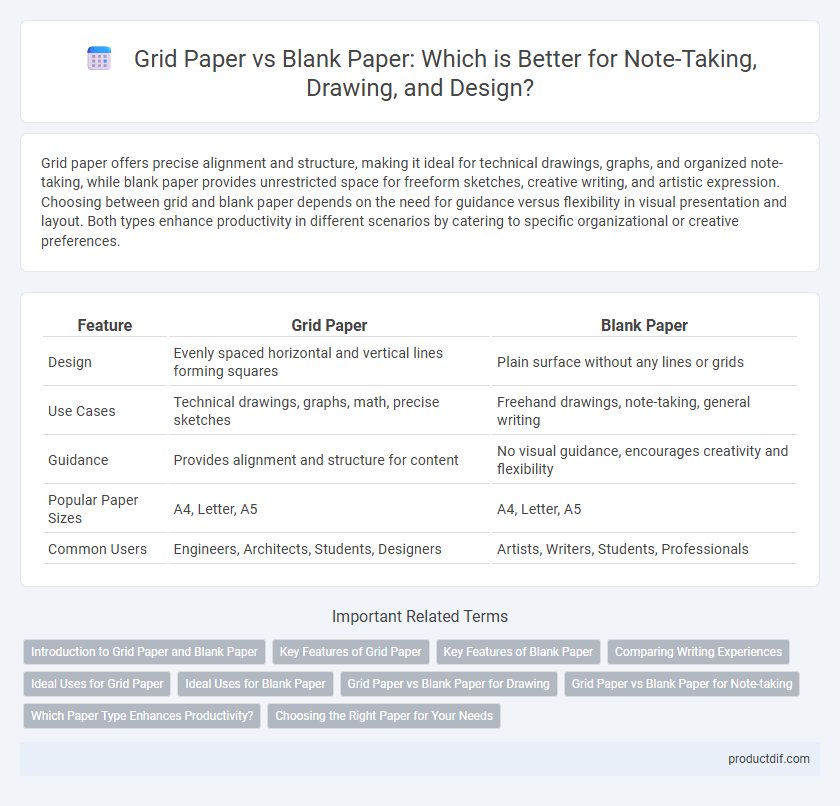Grid paper offers precise alignment and structure, making it ideal for technical drawings, graphs, and organized note-taking, while blank paper provides unrestricted space for freeform sketches, creative writing, and artistic expression. Choosing between grid and blank paper depends on the need for guidance versus flexibility in visual presentation and layout. Both types enhance productivity in different scenarios by catering to specific organizational or creative preferences.
Table of Comparison
| Feature | Grid Paper | Blank Paper |
|---|---|---|
| Design | Evenly spaced horizontal and vertical lines forming squares | Plain surface without any lines or grids |
| Use Cases | Technical drawings, graphs, math, precise sketches | Freehand drawings, note-taking, general writing |
| Guidance | Provides alignment and structure for content | No visual guidance, encourages creativity and flexibility |
| Popular Paper Sizes | A4, Letter, A5 | A4, Letter, A5 |
| Common Users | Engineers, Architects, Students, Designers | Artists, Writers, Students, Professionals |
Introduction to Grid Paper and Blank Paper
Grid paper features evenly spaced horizontal and vertical lines forming squares, ideal for precise drawings, graphs, and note organization in fields like engineering and mathematics. Blank paper offers an open, unlined surface, promoting creativity and freeform sketching, frequently used by artists and designers. Choosing between grid and blank paper depends on the need for structure or flexibility in visual expression and data representation.
Key Features of Grid Paper
Grid paper features evenly spaced horizontal and vertical lines that create precise squares, ideal for technical drawing, graphing, and mathematical calculations. It enhances accuracy in design layouts and data plotting by providing clear reference points for measurements and alignment. The structured format supports organized note-taking and helps maintain consistent spacing in handwriting and sketches.
Key Features of Blank Paper
Blank paper offers unmatched versatility due to its uninterrupted, smooth surface that supports freehand drawing, sketching, and creative writing without constraints. Its lack of predefined lines or grids allows for maximum customization, making it ideal for artists, designers, and note-takers who value flexibility. High-quality blank paper typically features acid-free composition and optimal thickness to prevent ink bleed-through, enhancing durability and presentation.
Comparing Writing Experiences
Grid paper offers structured guidance for precise drawings, graphs, and consistent handwriting, enhancing neatness and alignment. Blank paper allows unrestricted creativity for sketches and freeform writing but may result in less uniform text and layout. Writers who prioritize organization prefer grid paper, while those valuing artistic freedom lean toward blank sheets.
Ideal Uses for Grid Paper
Grid paper is ideal for technical drawing, graphing, and precise note-taking due to its evenly spaced horizontal and vertical lines that facilitate accurate measurements and alignment. It supports mathematicians, engineers, architects, and students in plotting functions, designing layouts, and organizing complex information clearly. The structure of grid paper enhances spatial reasoning and helps maintain consistent size and proportion in sketches and diagrams.
Ideal Uses for Blank Paper
Blank paper offers unparalleled versatility for sketching, brainstorming, and freeform note-taking, making it ideal for artists, designers, and creative thinkers who require unrestricted space for visual expression. Unlike grid paper, blank paper eliminates any distractions from pre-printed lines or boxes, allowing precise control over layout and design, which enhances creativity and innovation. Its smooth, unobstructed surface is particularly suited for calligraphy, detailed drawings, and mind-mapping, where fluid lines and organic shapes are essential.
Grid Paper vs Blank Paper for Drawing
Grid paper offers precise alignment and proportional accuracy, making it ideal for technical drawings, architectural sketches, and detailed designs. Blank paper provides complete freedom for creative expression without structural constraints, suitable for freeform illustrations and artistic sketches. Artists and designers often choose grid paper to maintain spatial organization, while blank paper supports fluid, uninhibited creativity.
Grid Paper vs Blank Paper for Note-taking
Grid paper enhances note-taking by providing structured alignment for diagrams, graphs, and neatly organized text, improving clarity and spatial arrangement. Blank paper offers unrestricted creative freedom, ideal for freeform sketches and mind maps without constraints. Choosing between grid and blank paper depends on whether precision or flexibility is prioritized in note-taking tasks.
Which Paper Type Enhances Productivity?
Grid paper enhances productivity by providing structured guidelines that improve alignment, precision, and organization in note-taking or design work. Blank paper offers creative freedom, ideal for brainstorming and sketching without constraints, but may lead to less organized output. Choosing between grid and blank paper depends on the task: grid paper suits technical and detailed work while blank paper favors freeform creativity.
Choosing the Right Paper for Your Needs
Grid paper offers structured guidance ideal for technical drawings, graphs, and precise note-taking, making it perfect for engineers, architects, and students in STEM fields. Blank paper provides unrestricted space for creative expression, suited for artists, designers, and brainstorming sessions where freeform sketches and ideas flow. Selecting the right paper depends on whether your task requires alignment and accuracy or open-ended creativity.
Grid paper vs Blank paper Infographic

 productdif.com
productdif.com